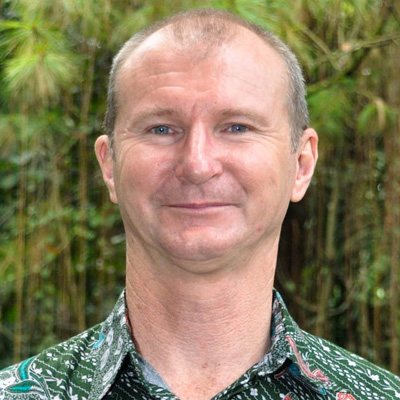
South Korea is focusing on the ‘blue carbon’ within mangroves and wetlands to help mitigate climate change as the country’s forested areas reach their limits and gradually lose their capacity to store carbon as trees age, according to participants at a recent symposium.
The event held on South Korea’s Jeju Island on 19 June 2023 was part of an international effort to build a global network of researchers working on coastal ecosystems and their ability to sequester carbon.
Scientists from South Korea, Vietnam and the Center for International Forestry Research and World Agroforestry (CIFOR-ICRAF) are examining the potential of mangrove species from Indonesia to be grown on Jeju – South Korea’s largest island – where semi-mangrove species are already established and starting to expand their area.
“In the next 50 years, Korea should go beyond terrestrial forests – which are ‘green’ carbon – to pay attention to the ‘forests of the sea’, such as mangroves and coastal wetlands, which are ‘blue’ carbon,” said Bae Jae Soo, president of South Korea’s National Institute of Forest Science (NIFoS), at the symposium. “These systems feature an excellent ability to absorb and fix carbon while preserving biodiversity in critical ecosystems.”
This year marks the 50th anniversary of the implementation of South Korea’s first 10-Year Forest Rehabilitation Plan, which began the highly successful regreening of vast areas of degraded land left behind after the Korean War.
Since 1960, the country has grown an estimated 12 billion trees, creating dense forests that absorb 40 million tonnes of greenhouse gases every year.
Paradoxically, however, it is largely impossible to further increase the area of forest because nearly every area that could be forested has been forested. Furthermore, the growth rates of the existing trees are decreasing each year as they age, meaning that their annual ability to store carbon also declines.
“CIFOR-ICRAF and NIFoS have recently started the new project that links Indonesia and Korea,” said Robert Nasi, chief operating officer of CIFOR-ICRAF. “Indonesia’s mangrove forests store three to five times more carbon per hectare than upland tropical forests; contribute 10‒15% of coastal sedimentary carbon storage while in global coastal areas they contribute only 0.50%; store 3.14 billion tonnes of carbon, which is one-third of global coastal carbon stocks; and provide a wide range of ecosystem goods and services for human survival and wellbeing.”
Scientists are evaluating carbon uptake capabilities and measuring carbon absorption capabilities in native habitats in Indonesia and in ‘smart’ greenhouses for the project on Jeju Island, according to Bora Lee, a researcher with NIFoS.
“We are evaluating the possibility of introducing mangroves and identifying potential locations in Jeju and perhaps elsewhere,” Lee said.
In some coastal areas of Jeju Province, semi-mangrove species, such as Hibiscus hamabo and Paliurus ramosissimus, grow and thrive naturally, according to Sung-Hyun Nam, minister of the Korea Forest Service.
“According to the current climate-change scenario, their total area will expand into the inland coast,” he said. “In this context, this symposium is designed to re-emphasize the importance of mangrove research and the role of mangroves in the global fight against climate change.”
Himlal Baral, co-leader of the research project and senior forest and landscape restoration scientist with CIFOR-ICRAF’s Climate Change, Energy and Low Carbon Development team, highlighted the huge demand for the services that mangroves offer in Indonesia, particularly in the area of fisheries.
“Large areas of mangroves are degraded or even denuded,” he said. “The key to restoring their services is the involvement of local communities, particularly in development of sustainable aquaculture.”
South Korea’s Ministry of Oceans and Fisheries has also been researching the ‘forests of the sea’, notably in neighbouring Vietnam, to tap the potential of aquaculture in mangroves and their hinterland. It estimates that the carbon-fixation ability of shellfish in aquaculture systems was approximately 23 tonnes per square kilometre per year compared with 0.37–18 tonnes on tidal flats.
In Vietnam, the mitigation potential of mangroves in the country is 4.4 million tonnes of carbon per year, with most mangroves growing in the deltas of the Mekong and Red rivers, but their area had declined by more than 13,000 ha from 1995 to 2019, according to Dong Thi Bich Ngoc and Tran Van Sang of the Management Board of Forestry Projects of Vietnam.
Vietnam’s mangrove forest area amounts to more than 150,000 ha with potential to implement activities to enhance carbon stocks under the REDD+ carbon-offset mechanism, they said. Meanwhile, sea grass beds cover over 15,000 ha and hold 2.60–5.95 million tonnes of carbon. However, of the 35 main beds, most were classified as ‘threatened’.
As a result, Vietnam’s government plans to extend its Payment for Forest Ecosystem Services Scheme to include mangroves and also further develop sustainable aquaculture systems.
For more information: Himlal Baral (h.baral@cifor-icraf.org) or Bora Lee (boralee7208@korea.kr)
The ‘Mangrove carbon dynamics and ecosystem services’ research study is conducted under a Cooperative Research Agreement between CIFOR-ICRAF and the National Institute of Forest Sciences of the Republic of Korea.
The study is intended to identify the carbon-sink capacity of mangroves native to East Asia and to discover species with a high possibility of successful application in Korea, in order to certify them as future carbon sink sources. Further, the research aims to identify the growth characteristics of mangroves by species, region and habitat conditions and to develop management methods as well as a stable proliferation regimen in the most suitable growing areas.
We want you to share Forests News content, which is licensed under Creative Commons Attribution-NonCommercial-ShareAlike 4.0 International (CC BY-NC-SA 4.0). This means you are free to redistribute our material for non-commercial purposes. All we ask is that you give Forests News appropriate credit and link to the original Forests News content, indicate if changes were made, and distribute your contributions under the same Creative Commons license. You must notify Forests News if you repost, reprint or reuse our materials by contacting forestsnews@cifor-icraf.org.












